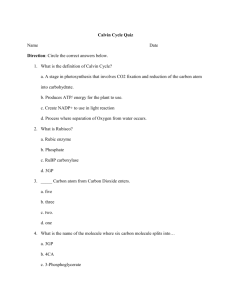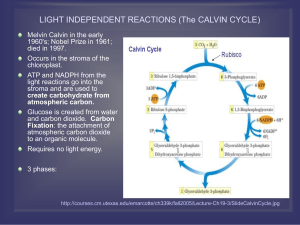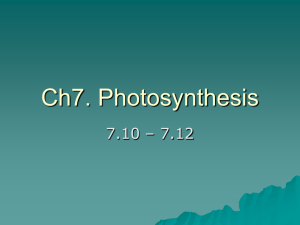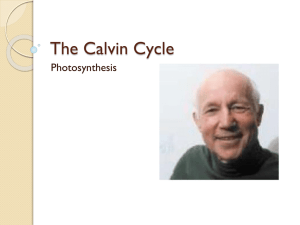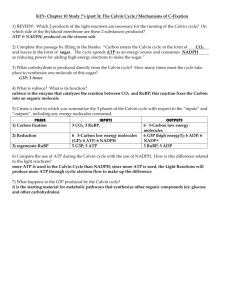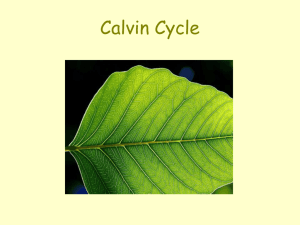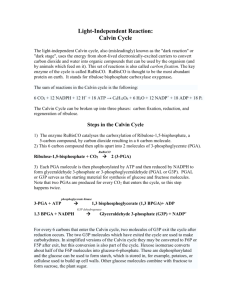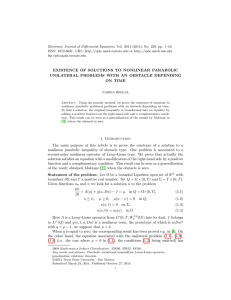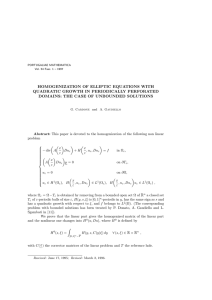The Calvin Cycle
advertisement
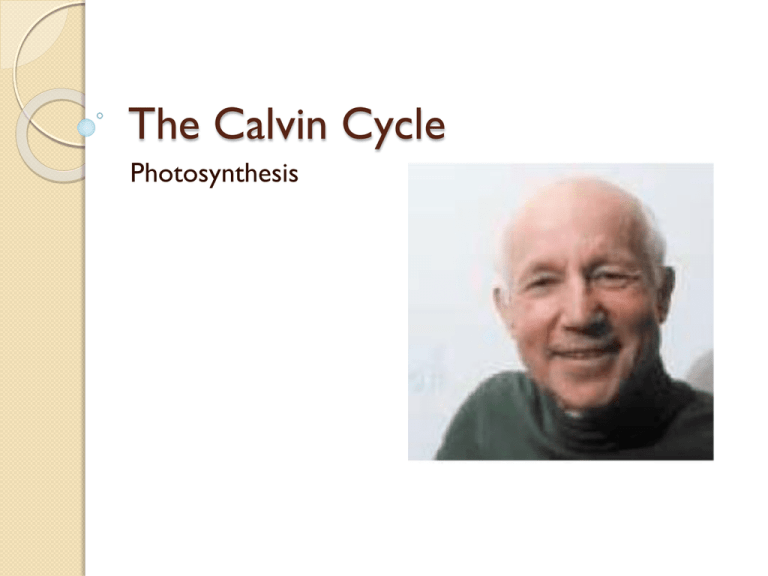
The Calvin Cycle Photosynthesis The Big Picture The Calvin cycle ◦ Occurs in the stroma ◦ Cyclic: ‘final’ product is the ‘initial’ reactant ◦ Details determined by Melvin Calvin, 1960. He received the Nobel Prize in 1961. ◦ Can be divided into three phases Carbon fixation Reduction Reactions Ribulose 1,5-bisphosphate (RuBP) regeneration Phase 1: Carbon Fixation The Calvin cycle is also known as C3 photosynthesis. Most plants are C3 plants. 3CO2 + 3 ribulose 1,5-bisphosphate (RuBP) (5C) 3 unstable 6C intermediates 3 6C splits into 6 ____ molecules: PGA INITIAL REACTANT(S) __________________ FINAL PRODUCT(S):____________________ ATP USED: ________________________ NADPH USED: ______________________ Reaction catalyzed by the enzyme: RIBULOSE BISPHOSPHATE CARBOXYLASE/OXYGENASE (RUBISCO) • enzyme works very slowly • typical plant enzymes process 1000 molecules/s. • rubisco: 3 molecules/s. • rubisco makes up about ½ all protein in a typical leaf MOST ABUNDANT PROTEIN ON EARTH! Phase 2: Reduction Reactions Each of the 6 3C PGA molecules is phosphorylated by an ATP to form ___ molecules of 1,3-BPG. Each 1,3-BPG reduced to glyceraldehyde 3-phosphate, G3P. ◦ 6 NADPH 6 NADP+ + 6 Pi 1 molecule of G3P exits the cycle as a final product. INITIAL REACTANT(S) __________________ FINAL PRODUCT(S):____________________ ATP USED: ____________________________ NADPH USED: ________________________ Phase 3: RuBP Regeneration 5 G3P (___C) 3 RuBP (__ C) Series of enzyme-catalyzed reactions. RuBP becomes a ‘reactant’ of the process. INITIAL REACTANT(S) __________________ FINAL PRODUCT(S):____________________ ATP USED: ____________________________ NADPH USED: ________________________ Why is the Calvin cycle x 3? 3 CO2 used at first. ◦ Three CO2 molecules must be fixed before one 3C molecule of G3P can be removed. ◦ Why?: need to maintain pool of intermediate molecules to sustain the cycle. ◦ 6 ‘turns’ of cycle fix enough to produce the equivalent of 1 glucose. Overall Reaction: For the NETsynthesis of ONE G3P molecule ___ ATP ___ NADPH are used. These molecules come from: ______________________. G3P will become: _______________ _______________ _______________ Which will be used in: _______________________ The Importance of G3P (1) When is that made, again? ◦ Recall that 6 G3P are formed during the reduction reactions of the Calvin cycle (Phase 2) ◦ One of the 6 G3P molecules is used to make glucose, starch, or sucrose... used in ____________________. ◦ G3P can be stored (as one of the former molecules) or act as a reactant in the Calvin cycle. The Importance of G3P (II) Higher plants generally fix more CO2 into sugars than they require for immediate energy needs. When conditions are optimal, and photosynthesis produces more glucose molecules than needed glucose is polymerized into amylose and amylopectin starch granules within chloroplasts. ◦ Which environmental conditions will cause ‘plants’ to store this starch? _______________________________________ ______________________________________ ◦ Which environmental conditions will cause ‘plants’ to use G3P immediately? _____________________ ◦ ______________________________________. Possible Paths of G3P Plants.... Possess many nonphotosynthetic tissues ◦ Roots ◦ Some stems ◦ Some flowers These tissues need energy to meet their needs. So how do they function? ◦ Plants have a ‘circulatory system’ just like we do. ◦ Xylem vessels move water and nutrients from the root to the stoma (via __________________) ◦ Phloem moves glucose (made by the ________) around the plant. Homework/Seatwork Page 166 # 9, 10, 11
